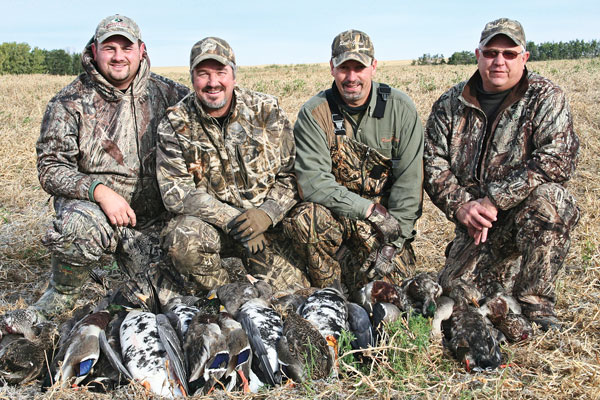October 08, 2014
By Joe Genzel
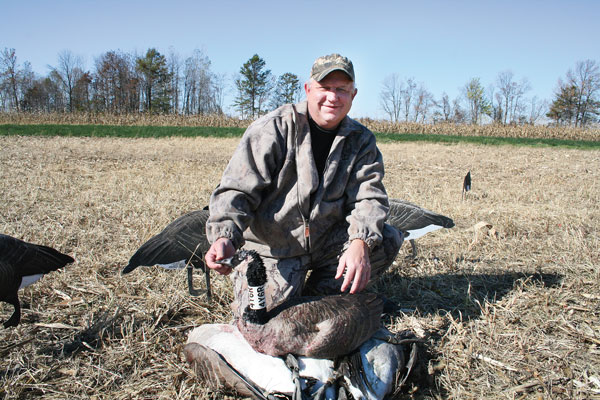 Hundreds of greenheads continued on an endless circle, looking to dump into a harvested field on Canada's western prairie. It's a dance any duck hunter who has spent time up north is all too familiar with. And most guys would kill for the chance to make it rain mallards on the trip of a lifetime.
Hundreds of greenheads continued on an endless circle, looking to dump into a harvested field on Canada's western prairie. It's a dance any duck hunter who has spent time up north is all too familiar with. And most guys would kill for the chance to make it rain mallards on the trip of a lifetime.
But Real-Geese Waterfowl Specialist Jim Slotterbeck is a Lake Erie boy, who spent most of the 1980s sitting in a burlap-wrapped blind all day to kill one darned Canada, and with snow geese on deck, the self-described "goose geek" turned to his legendary Eastern Shore compadre with a whisper. They were going to be patient.
"I was with Sean Mann and I just kept telling him to wait, because I wanted those snow geese to get to us before we shot the ducks," Slotterbeck said. "When I sat up, I didn't even see the ducks. Our (art director) and I both rose and shot the geese, because that's what we do."
Unlike many who have found success in the waterfowl industry, Slotterbeck did not grow up hunting ducks and geese. His father was an avid golfer and Jim spent much of his youth hitting the links with dad. He was pretty good too, shooting par and playing on the college team. There's no one moment Slotterbeck can point to that triggered the obsession to hunt. He just ended up going out with some friends on public land in northwest Ohio and that was that. It grabbed him, like it does so many of us.
Advertisement
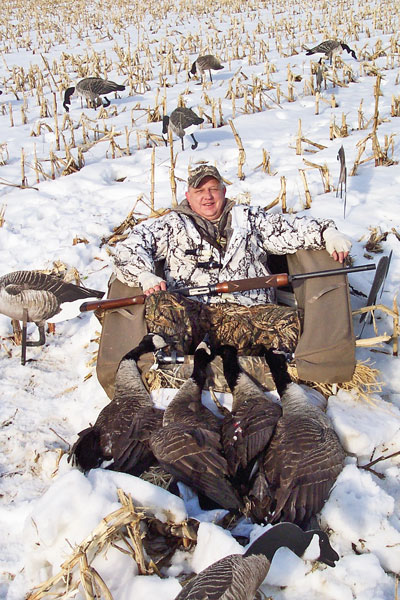 But it was not easy. Back in the '80s, the Canada population in his region was scarce, no more than a few thousand at the height of the season. Much of the good ground was locked up by lease. Jim wasn't in the position to pay to hunt. So he did the public-land thing, knocked on doors and made connections, relying on some golfing buddies for access.
But it was not easy. Back in the '80s, the Canada population in his region was scarce, no more than a few thousand at the height of the season. Much of the good ground was locked up by lease. Jim wasn't in the position to pay to hunt. So he did the public-land thing, knocked on doors and made connections, relying on some golfing buddies for access.
With no cash for decoys, he scrounged old silhouettes from farmers and refurbished them. The satisfaction of shooting one honker over goose cut-outs when every hunter and his brother were lining the hedgerows waiting to pass shoot birds flying off the refuge, was an indescribable feeling.
Slotterbeck worked in a facility that manufactured glass for General Motors. The factory closed, and after stints at a lime plant and coaching high school golf, he caught on with a custom decoy shop. His knowledge of waterfowl poses is extensive, and one of the many determining factors that brought him to Real-Geese. The decoy company, which specializes in silos, has 30 different bird postures so realistic you have to do a double-take when hunting alongside them.
Advertisement
His goose knowledge is far too extensive for us not to pass on. If you think more birds should be going on the strap, this man is going to give you the keys to kill'em close€¦and you can do it with a bag full of silhouettes and a plan.
WILDFOWL: First of all, how many Real-Geese silhouettes do we need for a decent spread?
Jim Slotterbeck: A good rule of thumb is three-dozen per person. The reason I tell anyone that is it's a fairly easy amount to carry. I can carry three-dozen in our silhouette bag, my gun, shells and layout blind, and make one trip into the field.
Two guys, that's six-dozen decoys. Ohio is somewhat unique in that most farmers won't let you drive into their fields. Here, you have to be pretty mobile and go wherever you can find the geese. By using silhouette decoys we're already a step ahead of the game, because if we have to walk a long ways we can still carry a good size spread without having to go back to the truck.
WF: How do you set the spread?
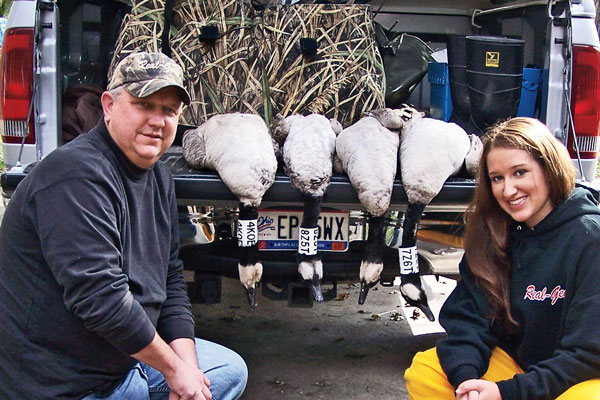 JS: You need to know which direction the birds are coming from, whether they are flying directly off a roost pond to your field or passing over. I like to have one group facing the direction of where the geese are coming from so they can see the decoys when they come over a tree line, or any obstacle between our spread and the birds.
JS: You need to know which direction the birds are coming from, whether they are flying directly off a roost pond to your field or passing over. I like to have one group facing the direction of where the geese are coming from so they can see the decoys when they come over a tree line, or any obstacle between our spread and the birds.
Then I have a group facing broad side to the wind as well. And space the silhouettes out at least three large steps. This gives each decoy a larger footprint. Sometimes geese will lock up a field over, and sometimes they will waver. I've found facing my decoys in both directions keeps them interested and gets their attention right off the bat.
WF: So do we need big numbers of silhouettes to pull this off?
JS: I believe in trying to emulate what I've seen in the past. If I'm scouting and I see 50 geese in the field, I'm not putting out 400 decoys. If it's late season and geese are coming from a single roost because the rest are all frozen up, then I might double that number.
There's a big difference if you're hunting a traffic field or an X field. In a traffic field, I'll always put out more decoys than if I am on the X.
WF: You hunt a lot of pressured areas. How do we kill birds that have seen it all?
JS: The first thing you have to do is hide well. There's just no doubt about that in my mind. If you're in an area with a lot of goose hunters and you see the decoy spreads, a lot of time it's really easy to pick out where the layouts are. I do like to flag.
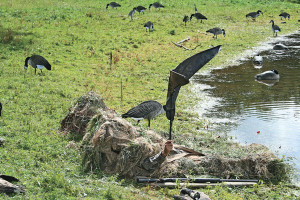 There are many days when I think flagging is more effective than calling, but keep in mind, when you're flagging it's drawing attention to your location as well. I like to get their attention. If they start to waver, flag a little bit more. We don't get up and run around in the decoys. We try to emulate one bird that's flapping its wings or just landed. If you watch geese on the ground — which I have my entire life — there's always one that wants to flap its wings.
There are many days when I think flagging is more effective than calling, but keep in mind, when you're flagging it's drawing attention to your location as well. I like to get their attention. If they start to waver, flag a little bit more. We don't get up and run around in the decoys. We try to emulate one bird that's flapping its wings or just landed. If you watch geese on the ground — which I have my entire life — there's always one that wants to flap its wings.
WF: If we're not great callers, can we still consistently get birds in the decoys?
JS: I've never been a contest caller, though I did judge the world goose calling championship in 2005, so I know a little bit about the sounds they make. It's almost impossible to make a sound with a modern goose call that geese don't make. The thing I think is important is when you make those sounds.
You can make the right sound at the wrong time, and it can cause more harm than good. Basically, calling is the same as flagging: get their attention, keep it and if they go off course, hit'em again. Once you have them coming, anything additional increases your chances of screwing it up. If the geese are on a string, let them come.
WF: Real-Geese makes duck silos too. How do we set up best for greenheads?
JS: If there are ducks around, I'll take a dozen or two of our mallards and put them on the back side of our Canada spread. Ducks often hop to the front of geese. I like to call'em little piggies because they want to get to the food before the geese do. But our goose silhouettes will work really well for ducks too. If there are ducks around and I only have the goose silhouettes out, I would still be pretty confident I could kill some ducks that day.
WF: You've had an extensive waterfowling career. At this point, what's your most memorable day afield?
JS: There's probably not one hunt that sticks out, but what I love is taking someone out who has never done it before and getting a goose in at five yards. But what I really want people to know is although I'm
fortunate enough to go on these hunts and go to places like Alberta, there's a lot of other people here that make Real-Geese go, from the folks that take and fill orders to the people on the floor every day.
It's always a team effort here and I'm just a small part of it.
